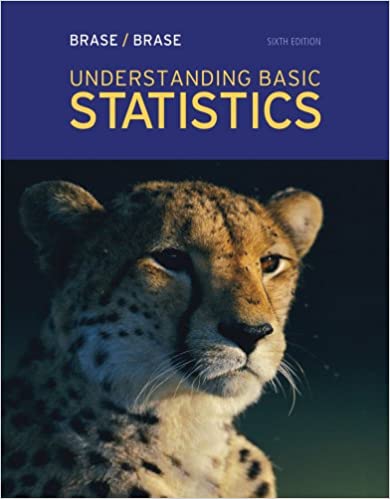
Understanding Basic Statistics 6th Edition by Charles Henry Brase,Corrinne Pellillo Brase
Edition 6ISBN: 978-1111827021
Understanding Basic Statistics 6th Edition by Charles Henry Brase,Corrinne Pellillo Brase
Edition 6ISBN: 978-1111827021 Exercise 126
Medical: Blood Glucose Let x be a random variable that represents the level of glucose in the blood (milligrams per deciliter of blood) after a 12-hour fast. Assume that for people under 50 years old, x has a distribution that is approximately normal, with mean = 85 and estimated standard deviation = 25 (based on information from Diagnostic Tests with Nursing Applications , edited by S. Loeb, Springhouse). A test result x 40 is an indication of severe excess insulin, and medication is usually prescribed.
(a) What is the probability that, on a single test, x 40
(b) Suppose a doctor uses the average
 for two tests taken about a week apart. What can we say about the probability distribution of
for two tests taken about a week apart. What can we say about the probability distribution of
 Hint: See Theorem 7.1. What is the probability that
Hint: See Theorem 7.1. What is the probability that
 40
40
(c) Repeat part (b) for n = 3 tests taken a week apart.
(d) Repeat part (b) for n = 5 tests taken a week apart.
(e) Interpretation Compare your answers to parts (a), (b), (c), and (d). Did the probabilities decrease as n increased Explain what this might imply if you were a doctor or a nurse. If a patient had a test result of
 40 based on five tests, explain why either you are looking at an extremely rare event or (more likely) the person has a case of excess insulin.
40 based on five tests, explain why either you are looking at an extremely rare event or (more likely) the person has a case of excess insulin.
(a) What is the probability that, on a single test, x 40
(b) Suppose a doctor uses the average
 for two tests taken about a week apart. What can we say about the probability distribution of
for two tests taken about a week apart. What can we say about the probability distribution of  Hint: See Theorem 7.1. What is the probability that
Hint: See Theorem 7.1. What is the probability that  40
40(c) Repeat part (b) for n = 3 tests taken a week apart.
(d) Repeat part (b) for n = 5 tests taken a week apart.
(e) Interpretation Compare your answers to parts (a), (b), (c), and (d). Did the probabilities decrease as n increased Explain what this might imply if you were a doctor or a nurse. If a patient had a test result of
 40 based on five tests, explain why either you are looking at an extremely rare event or (more likely) the person has a case of excess insulin.
40 based on five tests, explain why either you are looking at an extremely rare event or (more likely) the person has a case of excess insulin.Explanation
Given that x be a random variable that r...
Understanding Basic Statistics 6th Edition by Charles Henry Brase,Corrinne Pellillo Brase
Why don’t you like this exercise?
Other Minimum 8 character and maximum 255 character
Character 255


